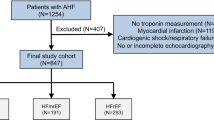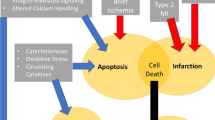Abstract
Despite evidence that cardiac troponin I (cTnI) identifies patients with advanced heart failure (HF) at risk of death, data on heterogeneous HF populations are scarce. Our purpose was to verify and analyze the prognostic role of cTnI in acute HF patients admitted to the emergency department. This was an observational longitudinal prospective study carried out in an urban hospital. We studied 99 patients discharged from the department between March and December 2002 with a HF diagnosis and samples of cTnI. Patients with acute coronary syndromes, myocarditis or renal failure were excluded. The main outcome was death from any cause. The detection level of the cTnI assay was 0.05 ng/ml. cTnI was detected in 45.5% of HF patients. These patients had a higher NYHA class (P < 0.001) at initial presentation and longer hospitalization (P = 0.004) than cTnI-negative patients. Nineteen deaths occurred during the study: 17 for HF and 2 for acute coronary syndrome. Finally, detectable cTnI was associated with increased mortality risk (RR 4.7; 95% CI 1.3–17.1; P = 0.021) also after adjustment for other adverse prognosis factors (age, NYHA class and presence of relapses). Our HF cTnI-positive patients had a worse clinical presentation and longer hospitalization. cTnI is a significant independent predictor of death and of longer hospitalization. It could be used for the early identification of HF patients at an increased risk of death in the long term, and of longer hospitalization. Thus, cTnI can aid decision-making and clinical management in the emergency department.

Similar content being viewed by others
References
Coudrey L (1998) The troponins. Arch Intern Med 158:1173–1180
Ni CY (2001) Cardiac troponin I: a biomarker for detection and risk stratification of minor myocardial damage. Clin Lab 47(9, 10):483–492
Hamm CW, Goldmann BU, Heeschen C et al (1997) Emergency room triage of patients with acute chest pain by means of rapid testing for cardiac troponin T or trponin I. N Engl J Med 337:1648–1653
Polanczyk CA, Lee TH, Cook F (1998) Cardiac troponin I as a predictor of major cardiac events in emergency department patients with acute chest pain. J Am Coll Cardiol 32:8–14
Antman EM, Tanasijevic MJ, Thompson B et al (1996) Cardiac-specific troponin I levels to predict the risk of mortality in patients with acute coronary syndromes. N Engl J Med 335:1342–1349
Sato Y, Kita T, takatsu Y, Kimura T (2004) Biochemical markers of myocyte injury in heart failure. Heart 90:1110–1113
Roongsritong C, Warraich I, Bradley C (2004) Common causes of troponin elevations in the absence of acute myocardial infarction: incidence and clinical significance. Chest 125(5):1877–1884
Missov E, Calzolari C, Pau B (1997) Circulating cardiac troponin I in severe congestive heart failure. Circulation 96:2953–2958
Del Carlo CH, O’Connor CM (1999) Cardiac troponins in congestive heart failure. Am Heart J 138:646–653
Sakhuja R, Green S, Eveline M (2007) Amino-terminal pro-brain natiuretic peptide, brain natiuretic peptide, and troponin t for prediction of mortality in acute heart failure. Clin Chem 53(3):12–420
La Vecchia L, Mezzena G, Zanolla L et al (2000) Cardiac troponin I as diagnostic and prognostic marker in severe heart failure. J Heart Lung Transplant 19:644–652
Guler N, bilge M, Eryonucu B et al (2001) Cardiac troponin I levels in patients with left heart failure and cor pulmonale. Angiology 52:317–322
Healey JS, Davies RF, Smith SJ et al (2003) Prognostic use of cardiac troponin T and troponin I in patients with heart failure. Can J Cardiol 19(4):383–386
Horwich TB, Patel J, MacLellan WR et al (2003) Cardiac troponin I is associated with impaired hemodynamics, progressive left ventricular dysfunction, and increased mortality rates in advanced heart failure. Circulation 108:833–838
Boffa GM, Zaninotto M, Bacchiega E et al (2005) Correlations between clinical presentation, brain natriuretic peptide, big endothelin-1, tumor necrosis factor-alfa and cardiac troponins in heart failure patients. Ital Heart J 6(2):125–132
Gheorghiade M, Stough WG, Adams KF Jr et al (2005) The pilot randomized study of Nesiritide versus dobutamine in heart failure (PRESERVD-HF). Am J Cardiol 96(Suppl):18G–25G
Gattis WA, O’Connor CM, Hasselblad V, Adams KF Jr, Kobrin I, Gheorghiade M (2004) Usefulness of an elevated troponin-I in predicting clinical events in patients admitted with acute heart failure and acute coronary syndrome (from the RITZ-4 Trial). Am J Cardiol 93:1436–1437
La Vecchia L, MezzenaG, Ometto R et al (1997) Detectable serum troponin I in patients with heart failure of of nonmyocardial ischemic origin. Am J Cardiol 80(1):482–485
Ho KL, Pinsky JL, Kennel WB et al (1993) The epidemiology of heart failure: the Framingham study. J Am Coll Cardiol 22(Suppl A):6A
Myocardial Infarction Redefined: A Consensus Document of the Joint European Society of Cardiology/American College of Cardiology (2000) Committee for the redefinition of myocardial infarction. J Am Coll Cardiol 36:959–969
Brown CS, Bertolet BD (1997) Cardiac troponins. See ya later. CK [editorial; comment]. Chest 111:2–4
Van de Werf F (1996) Cardiac troponins in acute coronary syndromes. N Engl J 335:1388–1389
Adams JE III, Bodor GS, Davila-Roman VG et al (1993) Cardiac troponin I a marker with high specificity for cardiac injury. Circulation 88:101–106
Adams JE III, Apple FS, Jaffe AS, WU AHB (2002) Markers in cardiology: current and future clinical application. Blackwell, Oxford
Rector TS, Cohn JN (1996) Prognosis in congestive heart failure. Annu Rev Med 45:341
Marubini E, Valsecchi MG (1995) Analysing survival data from clinical trials and observational studies. Wiley, Chichester
Logeart D, Beyne P, Cusson C et al (2001) Evidence of cardiac myolysis in severe nonischemic heart failure and the potential role of increased wall strain. Am Heart J 141:247–253
Scrutinio D, Lagioia R, Ricci A et al (1994) Prediction of mortalità in mild to moderately symptomatic patients with left ventricular dysfunction: the role of the New York Heart Association classification, cardiopulmonary exercise testing, two-dimensional echocardiography and Holter monitoring. Eur Heart J 15:1089–1095
Muntwyler J, Abetel G, Gruner C et al (2002) One year mortality among unselected outpatients with heart failure. Eur Heart J 23:1861–1866
Ahmed A, Aronow WS, Fleg J (2006) Higher New York Heart Association classes and increased mortality and hospitalization in patients with heart failure and preserved left ventricular function. Am Heart J 151:444–450
Petrie MC, Berry C, Stewart S, McMurray JJV (2001) Failing ageing hearts. Eur Heart J 22:1978–1990
Effects of Enalapril on Mortality in Severe Congestive Heart Failure (1987) Results of the Cooperative North Scandinavian Enalapril Survival Study (CONSENSUS). The CONSENSUS Trial Study Group. N Engl J Med 316 (23):1429–1435
Hughes CV, Wong M, Johnson G, Cohn JN (1993) Influence of age on mechanism and prognosis of heart failure: The V-HeFTVA Cooperative Studies Groups. Circulation 87(6 Suppl):VI 111–VI 1117
Wolinsky FD, Overhage JM, Stump TE, Lubitz RM, Smith DM (1997) The risk of hospitalization for congestive heart failure among older adults. Med Care 35(10):1031–1043
Author information
Authors and Affiliations
Corresponding author
Additional information
A short abstract of the paper was presented at the A.C.E.P. Scientific Assembly-Research Forum in Boston U.S.A. October 2003.
Rights and permissions
About this article
Cite this article
Parenti, N., Bartolacci, S., Carle, F. et al. Cardiac troponin I as prognostic marker in heart failure patients discharged from emergency department. Intern Emerg Med 3, 43–47 (2008). https://doi.org/10.1007/s11739-008-0092-8
Received:
Accepted:
Published:
Issue Date:
DOI: https://doi.org/10.1007/s11739-008-0092-8




